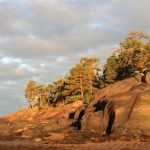Island Kiy is a masterpiece of the northern nature.
It is situated in the Onezhsky Gulf of the White Sea, 15 kms from the ancient Russian town Onega. It is 2 kms long and not more than 800 meters wide.
The trifling territory of the island can show all diversity of northern landscapes, i.e. huge granite cliffs and tiny lakes in remote places of the isle.
500 species of plants grow on the island, the coastal water is rich of fish and is warmed up to 24 °C in summer. Granitic grey of 25 meters high cliffs, vast sandy beaches and great pine forests full of berries, exceptionally interesting architectural ensemble and the history of the Kiy Holy Cross monastery, the original nature of the island attract thousands of tourists.
The history of Kiy island is closely connected with the name of a well-known religious figure of the 17th century patriarch Nickon who reformed the Russian Orthodox Church.
According to the legend during a ruff storm Nickon lost all his fellow-travellers but found his rescue on the island. In memory of his miraculous rescue Nickon founded the Holy Cross monastery on the island (17th century). This is one of the three monasteries founded on his own initiative. They were the bulwark of his power and they championed the ideas of the church reform.
ARCHITECTURAL ENSEMBLE OF THE HOLY CROSS MONASTERY.
One can see several buildings in the monastery, many of them have tracks of recent restoration. The monastery is located at the southern end of the island on the flattest and highest place. The western facades of churches face the sea. The altar facades face the square of the monastery. The buildings of the Exaltation of the Holy Cross Cathedral, of the refectory and the Over-the Well church form a close unit. Their walls are made of granite boulders and bricks, so alongside with surrounding cliffs they look like monolith.
The Cathedral of the Exaltation of the Holy Cross (1660) dominates the island. It is built on the natural granite foundation. The temple is almost cubical, and its walls are inclined inside. A huge eightsided drum and a dome crown the cube. Nowadays it has one cupola, though primordially it had 5 cupolas (according to other data – 3). The apses of the cathedral on the eastern side protrude wavily, the central one is a little higher and larger, a small dome is over it. Perspective keel-like beautiful portals of white stone open into the cathedral on its 3 sides.
The organization of the inner space is unusual. There is a gallery among the pillars on the west side. A narrow inner staircase leads to the gallery. The cathedral is extraordinarily spacious and light thanks to wide windows.
The second stone structure of the monastery was the Church of the Procession of the Precious Wood of Christ or the Over-the Well Church (1660). The church is small, it has one dome. It is made of boulders and bricks. A cross-like slab of white stone is fixed to the outer side of the altar apse. There is an inscription about the foundation of the monastery on it.
A two-storied building adjoins the church on the west. Erstwhile the main premises of the monastery, such as the brewery of kvass, the large kitchen, the bakery of communion bread and household cellars were situated there. Dwellings were on the second story.
There is also the Church of the Nativity of the Blessed Virgin (1660) with the refectory and adjoining belfry tower and the burial-vault of abbots. The belfry tower can’t be noticed at once because all its tiers were disassembled after closing the monastery down.
The wooden Church of all the Saints (1661) lurks in the innermost of the island. It was built on the cemetery of the monastery. Now it has been rebuilt and is used as an accommodation.
A small fragment of a wooden fence with a small tower (1871) is still intact on the island. Earlier there were 7 towers on the wall, besides a lot of loopholes, inner passages and 8 canons. The first wall was built in 1658.
Nowadays the monastery accepts pilgrims from all parts of Russia.
Since 1924 the rest hose «Kiysky» has been functioning on the island.









